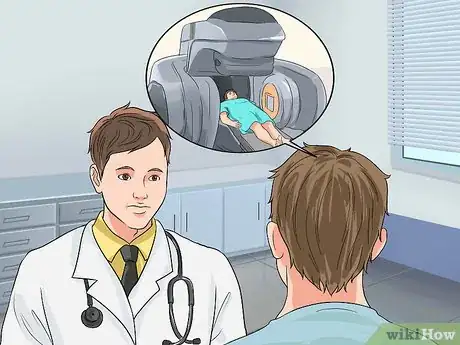This article was co-authored by Kevin Stone, MD. Dr. Kevin Stone is an orthopaedic surgeon and the founder of The Stone Clinic, a leading orthopaedic surgery, sports medicine, and rehabilitation clinic in the San Francisco Bay Area. With over 30 years of experience, Dr. Stone specializes in knee, shoulder, and ankle repair, using biologic reconstruction and joint replacement. He holds a BS in Biology from Harvard University and a Doctor of Medicine (MD) from the University of North Carolina at Chapel Hill. Dr. Stone completed his residency in Internal Medicine and Orthopaedic Surgery at Harvard University and in General Surgery at Stanford University. He then completed a fellowship in Orthopaedic Research and Surgery at the Hospital for Special Surgery and Tahoe Orthopaedics. He lectures around the world as an expert in cartilage and meniscal growth, replacement, and repair and holds over 40 U.S. patents on novel inventions to improve healthcare. Dr. Stone is a physician for Smuin Ballet and has served as a physician for the U.S. Ski Team, the U.S. Pro Ski Tour, the United States Olympic Training Center, and World Pro Ski Tour.
There are 12 references cited in this article, which can be found at the bottom of the page.
This article has been viewed 27,140 times.
Bone cancer is a fairly rare disease, so if you've developed bone pain, don't jump to conclusions. However, you should still check your symptoms and talk to your doctor, as symptoms like bone pain, fractures, swelling, and fatigue can indicate cancer or another issue that needs to be treated. If your doctor suspects you have cancer, they will likely order a series of tests to determine if you have cancer and how advanced it is if you do.
Steps
Watching for Symptoms of Bone Cancer
-
1Pay attention to bone pain. One of the main symptoms of bone cancer is pain in the affected bone. It often grows worse over time. You may notice the pain more at certain times, such as at night or when you're using the affected area.[1]
- You might start limping if the cancer is in a leg bone.
- If you've had a sore bone for a while, followed by sudden pain in that limb, that could mean you have a fracture in that bone, which can also develop from bone cancer.
-
2Look for swelling. Swelling may also occur around the affected area, so pay attention if you have pain accompanied by swelling, particularly if you haven't had an injury in that area. Swelling can show up a week or 2 after the pain, and you may also notice a lump or mass in the area.[2]Advertisement
-
3Notice fatigue. Like any cancer, bone cancer is going to leave you fatigued. You may find you can't keep your eyes open or that you just don't have the energy to do the things you normally do. If you notice this symptom in conjunction with others, it's time to talk to your doctor.[3]
-
4Watch for weight loss. If you're not trying to lose weight and you're suddenly dropping pounds, that could be a symptom of bone cancer. Talk to your doctor if you have this symptom in conjunction with other symptoms.[4]
-
5Check for a fever. While a fever is not as common a symptom as others on this list, bone cancer can cause you to have a fever. Check your temperature with a thermometer if you think you have a fever. Anything over 100.4 °F (38.0 °C) is cause for you to talk to your doctor.[5]
-
6Notice sweating. Sometimes, bone cancer can cause you to sweat more than normal. You may notice this symptom particularly at night. Of course, you may sweat for a number of reasons, but you should tell your doctor about this symptom if you notice it in connection to other symptoms.[6]
- The most important lifestyle change one can make to ensure healthy bones and skeletal system is to optimize their weight and fitness.
- Adding 10 pounds to your body can increase the forces in your leg joints up to two to five times.
- You put pressure up to two to five times your body weight on each leg and take 2 to 3 million steps per year in normal walking.
Visiting the Doctor
-
1Write down your symptoms before the appointment. If you have noticed these symptoms, it's time to go in and see your doctor, particularly if you have bone pain or unexplained swelling. When you go to the doctor, write down the symptoms you're having, including when you have them and what makes them worse.[7]
-
2Expect a physical exam. The doctor will begin with a physical exam. They will examine the area that's causing you pain, as well as look for other physical ailments. They will also listen to your heartbeat and breathing.[8]
- Ask questions if you don't understand.
-
3Accept a referral if your doctor suspects cancer. Generally, you'll go to your general practitioner first. However, if your doctor does think it might be cancer, they may refer you to a specialist. On the other hand, they may order diagnostic tests to narrow down the issue.[9]
Using Diagnostic Tests for Bone Cancer
-
1Be ready for an x-ray. An x-ray is often the first test a doctor will order. Many bone cancers will show up on an x-ray. While a doctor may be able to see a tumor, the x-ray will only tell the doctor if it's there, not if it's malignant (cancer) or benign (not cancer).[10]
-
2Expect a biopsy. A biopsy is when the doctor removes a sample of tissue from a tumor to send to a laboratory. The lab then tests the tissue to see if the tissue is cancerous or not.[11]
- The doctor may perform a needle biopsy, where they insert a large needle into the tumor to remove tissue. They will apply an anesthetic first.
- On the other hand, they may perform a surgical biopsy. In this case, they will cut into your skin, and then take either a piece of the tumor or the whole tumor. Before the biopsy, they will give you appropriate pain meds or anesthesia.
-
3Ask about a computed topography (CT) scan. If your doctor suspects the cancer has spread, then they may order a CT scan. However, they may also order one to help do a biopsy, since they can use it to show them where the needle should go.[12]
- A CT scan is basically a series of x-rays that the computer forms into a 3D image of your body.[13]
-
4Be ready for a MRI. Another scan the doctor may use is an magnetic resonance imaging (MRI) scan. These scans use radio waves and magnetic fields to produce images, and they are useful for looking at soft tissue. These scans show whether the cancer, if there is any, has spread to surrounding tissue.[14]
-
5Agree to a bone scan. If your doctor locates cancer, they may order a bone scan to get a closer look. A bone scan is a type of x-ray, but they use a needle to inject a bit of radiation into your veins so they can get a more detailed look. [15]
-
6Ask your doctor what stage of cancer you're in, if you have it. After your doctor has reviewed your tests, they should be able to tell you if you have cancer and what stage it is in. Stages range from stage I to stage IV, depending on the severity of your cancer.[16]
- Stage I is cancer completely confined to 1 bone. Also, the cancer is not aggressive.
- Stage II means the cancer is confined to 1 bone, but the cancer is aggressive.
- In stage III, the cancer has developed in multiple places on the same bone.
- Stage IV cancer means it has spread to other areas of the body.
References
- ↑ https://www.cancer.org/cancer/bone-cancer/detection-diagnosis-staging/signs-symptoms.html
- ↑ https://www.cancer.org/cancer/bone-cancer/detection-diagnosis-staging/signs-symptoms.html
- ↑ https://my.clevelandclinic.org/health/diseases/17745-bone-cancer
- ↑ https://www.cancer.org/cancer/bone-cancer/detection-diagnosis-staging/signs-symptoms.html
- ↑ https://my.clevelandclinic.org/health/diseases/17745-bone-cancer
- ↑ https://www.nhs.uk/conditions/bone-cancer/symptoms/
- ↑ https://www.cancerresearchuk.org/about-cancer/bone-cancer/getting-diagnosed/seeing-your-gp
- ↑ https://www.cancer.org/cancer/bone-cancer/detection-diagnosis-staging/how-diagnosed.html
- ↑ https://www.cancerresearchuk.org/about-cancer/bone-cancer/getting-diagnosed/seeing-your-gp
- ↑ https://www.cancer.org/cancer/bone-cancer/detection-diagnosis-staging/how-diagnosed.html
- ↑ https://my.clevelandclinic.org/health/diseases/17745-bone-cancer
- ↑ https://www.cancer.org/cancer/bone-cancer/detection-diagnosis-staging/how-diagnosed.html
- ↑ https://www.nhs.uk/conditions/bone-cancer/diagnosis/
- ↑ https://www.nhs.uk/conditions/bone-cancer/diagnosis/
- ↑ https://www.nhs.uk/conditions/bone-cancer/diagnosis/
- ↑ https://www.urmc.rochester.edu/encyclopedia/content.aspx?contenttypeid=34&contentid=24888-1
About This Article
To diagnose bone cancer, watch for possible symptoms, such as bone pain, swelling, fatigue, or weight loss. If you notice any of these symptoms, talk to your doctor. Your doctor can perform a physical exam and refer you to a specialist if they suspect cancer. When you see the specialist, expect to have x-rays or an MRI to look for signs of cancer. If the doctor finds a tumor, they’ll order a biopsy to see if the tissue is cancerous. To learn how to talk to your doctor about the different stages of bone cancer, keep reading!




















-Step-13.webp)


-Step-8-Version-3.webp)



















































Medical Disclaimer
The content of this article is not intended to be a substitute for professional medical advice, examination, diagnosis, or treatment. You should always contact your doctor or other qualified healthcare professional before starting, changing, or stopping any kind of health treatment.
Read More...